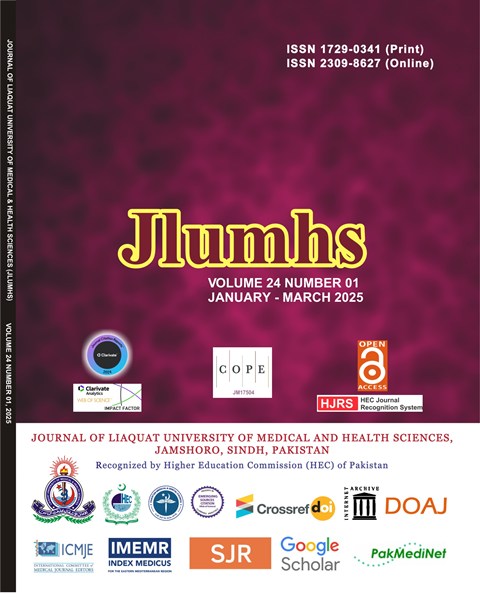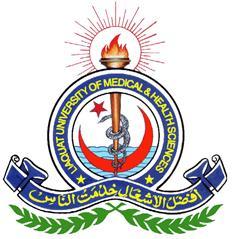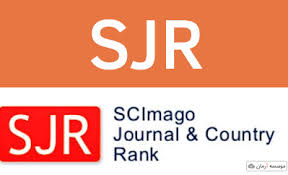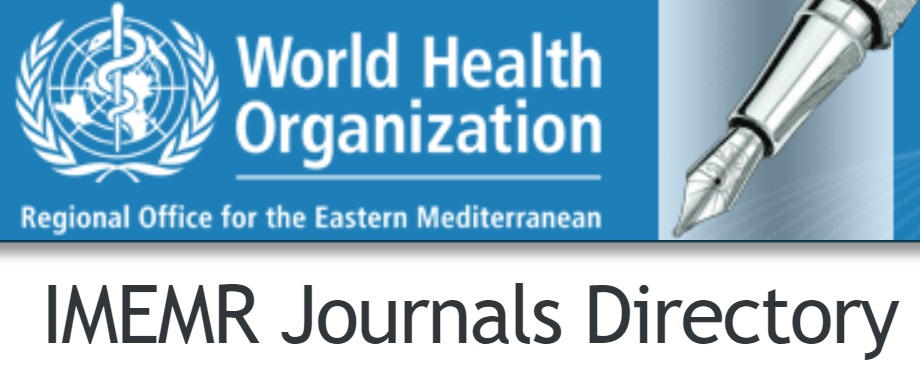Micro-Organisms Isolated from Open Fractures of Extremities
Keywords:
Micro-organisms, open fractures of extremities, Culture, InfectionAbstract
OBJECTIVE: To determine the frequency of micro-organisms from culture reports of open fractures of extremities.
METHODOLOGY: In this descriptive cross-sectional study carried out in the orthopedic surgery department of Lady Reading Hospital in Peshawar, 173 patients with open fractures lasting more than five days were included. The trial lasted for six months. Consecutive non-probability sampling was used. Swabs were collected from the fracture wounds. Swabs were inoculated on Blood agar, MacConkey agar and chocolate agar. Different biochemical tests were used to identify the Micro-organisms.
RESULTS: Analysis of 173 patients' ages revealed that the patients were 18-67 years old, with a mean age of 28.6±3. Analysis of the gender-wise distribution of the 173 patients showed that 92(53.2%) were men and 81(46.8%) were women. Analysis of the distribution of micro-organisms among 173 patients revealed that 45(26%) and 36(20.8%) of them were staphylococcus aureus and Streptococcus. Staphylococcus epidermidis were 32 (18.5%). Pseudomonas aeruginosa were 34(19.7%) and E Coli were 26 (15.02%). The Gustilo classification was used to examine the distribution of fractures among 173 patients. Grade 1 consisted of 31, Grade II consisted of 48, Grade III consisted of 80, Grade IIIB consisted of 8, and Grade IIIC consisted of 6.
CONCLUSION: This study concludes that both staphylococcus aureus were the frequent micro-organisms involved in open fracture infections.
References
Kale AR, Sonawane CS, Waghmare VU, Kalambe H. Open fractures and incidence of infection in tertiary care government hospital. Int J Sci Stud. 2017; 5(5): 24-28.
Bucholz RW, Heckman JD, Court-Brown C, editors. Rockwood and Green's Fractures in Adults. 6th ed. Philadelphia: Lippincott Williams & Wilkins; 2006.
Beaty JH, Kasser JR, editors. Rockwood and Wilkins' Fractures in Children. 5th ed. Philadelphia: Lippincott Williams & Wilkins; 2005.
Ruedi T, Buckley R, Moran C eds. AO Principles of Fracture Management. New York: Thieme; 2007.
Naeem U, Habibullah S, Amer HK. Common organisms and their sensitivity in open fractures of the Extremities. Pak J Surg. 2012; 28(3): 186-92.
Reddy L, John AS, Sheela D, Syed N, James J. Predebridement wound culture in open fractures does not predict postoperative wound infection: a pilot study. J Nat Sci Biol Med. 2015; 6: S63-S68.
Hasan O, Rahim Khan HA, Mustafa SF, Muhammad ZA, Ahmad T. Use of bacterial cultures in open wound fractures: a prospective cohort study. IJS Short Rept.2018; 3: 52-7.
Amit RK, Chandrashekhar SS, Vijay UW, Harshal K. Open fractures and incidence of infection in tertiary care government hospital. Int J Sc Study. 2017; 5(5): 24-29.
Zeb A, Ullah Z, Ullah F, Safder A, Khan Y, Naseem U. Bacterial Spectrum and Antibiotic Sensitivity in open Fractures of the Extremities. Pak J Med Health Sci. 2022; 16(05): 1192.
Carmont MR. The Advanced Trauma Life Support course: a history of its development and review of related literature. Postgrad Med J. 2005; 81(952): 87-91.
Carley S, Driscoll P. Trauma education. Resuscitation. 2001; 48(1): 47-56.
Collicott PE. Advanced Trauma Life Support (ATLS): past, present, future-16th Stone Lecture, American Trauma Society. J Trauma. 1992; 33(5): 749-753.
Bosch F, Rosich L. The contributions of Paul Ehrlich to pharmacology: a tribute on the occasion of the centenary of his Nobel Prize. Pharmacology. 2008; 82(3): 171-179.
Kindsfater K, Jonassen EA. Osteomyelitis in grade II and III open tibia fractures with late debridement. J Orthop Trauma. 1995; 9(2): 121-127.
Bednar DA, Parikh J. Effect of time delay from injury to primary management on the incidence of deep infection after open fractures of the lower extremities caused by blunt trauma in adults. J Orthop Trauma. 1993; 7(6): 532-5.
Spencer J, Smith A, Woods D. The effect of time delay on infection in open long-bone fractures: a 5-year prospective audit from a district general hospital. Ann R Coll Surg Engl. 2004; 86(2): 108-112.
Noumi T, Yokoyama K, Ohtsuka H, Nakamura K, Itoman M. Intramedullary nailing for open fractures of the femoral shaft: evaluation of contributing factors on deep infection and nonunion using multivariate analysis. Injury. 2005; 36(9): 1085-1093.
Skaggs DL, Friend L, Alman B, Chambers HG, Schmitz M, Leake B, Kay RM et al. The effect of surgical delay on acute infection following 554 open fractures in children. J Bone Joint Surg Am. 2005; 87(1): 8-12.
Arruda LRP, Silva MAC, Malerba FG, Fernandes MC, Turíbio FM, Matsumoto MH. Fraturas expostas: estudo epidemiológico e prospectivo. Acta Ortop Bras. 2009; 17(6): 326-330.
20. Müller SS, Sadenberg T, Pereira GJC, Sadatsune T, Kimura EE, Novelli JLV. Filho Estudo epidemiológico, clínico e microbiológico prospectivo de pacientes portadores de fraturas expostas atendidos em hospital universitário. Acta Ortop Bras. 2003; 11(3): 158-169.
Swanson TV, Szabo RM, Anderson DD. Open hand fractures: prognosis and classification. J Hand Surg Am. 1991; 16(1): 101-107.
Taffinder NJ, McManus IC, Gul Y, Russell RC, Darzi A. Effect of sleep deprivation on surgeons' dexterity on laparoscopy simulator. Lancet. 1998; 352(9135): 1191-1191.
Arnedt JT, Owens J, Crouch M, Stahl J, Carskadon MA. Neurobehavioral performance of residents after heavy night call vs after alcohol ingestion. JAMA. 2005; 294(9): 1025-1033.
Downloads
Published
How to Cite
Issue
Section
License
Copyright (c) 2025 Journal of Liaquat University of Medical & Health Sciences

This work is licensed under a Creative Commons Attribution-NonCommercial-ShareAlike 4.0 International License.
Submission of a manuscript to the journal implies that all authors have read and agreed to the content of the undertaking form or the Terms and Conditions.
When an article is accepted for publication, the author(s) retain the copyright and are required to grant the publisher the right of first publication and other non-exclusive publishing rights to JLUMHS.
Articles published in the Journal of Liaquat University of Medical & health sciences are open access articles under a Creative Commons Attribution-Noncommercial - Share Alike 4.0 License. This license permits use, distribution and reproduction in any medium; provided the original work is properly cited and initial publication in this journal. This is in accordance with the BOAI definition of open access. In addition to that users are allowed to remix, tweak and build upon the work non-commercially as long as appropriate credit is given and the new creations are licensed under the identical terms. Or, in certain cases it can be stated that all articles and content there in are published under creative commons license unless stated otherwise.























